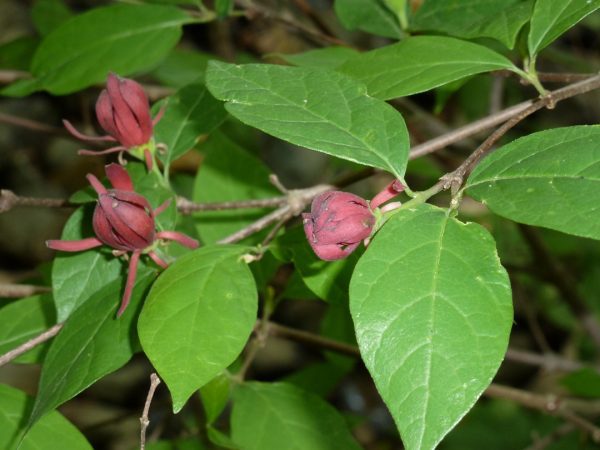Uncommonly lovely spring shrubs

When the flush of spring ephemeral wildflowers begins to fade, several shrub species come into their own. Mountain laurel ought to be at its peak in the coming week. Their enchanting masses of light pink flowers are found throughout the Uwharries, but some of our most interesting and attractive spring-blooming shrubs aren’t nearly so abundant. Look for them in mature hardwood forests, scattered along streambanks and tucked away in rocky ravines.
 Bladdernut (Staphylea trifolia) is a shrub or small understory tree with three-lobed leaves found in moist, rich soil. It generally begins to bloom in early April. The drooping clusters of white, bell-shaped flowers later mature to curious papery fruits that resemble inflated balloons or Japanese lanterns. The puffy, three-chambered bladders hold one to four seeds which are reportedly adored by woodland mice.
Bladdernut (Staphylea trifolia) is a shrub or small understory tree with three-lobed leaves found in moist, rich soil. It generally begins to bloom in early April. The drooping clusters of white, bell-shaped flowers later mature to curious papery fruits that resemble inflated balloons or Japanese lanterns. The puffy, three-chambered bladders hold one to four seeds which are reportedly adored by woodland mice.
Return to the same habitat a few weeks later to search for eastern sweetshrub (Calycanthus floridus). Their buds – which resemble old-fashioned Christmas tree lights – unfurl to strappy, burgundy petals. The blooms emit a heady fragrance. I most often smell them before I see them. Once I get a whiff of their fruity scent, I follow my nose to the source. The blooms were once prized by women and girls in need of a corsage to adorn the bodice of a party dress, perhaps earning them the endearing common name, sweet bubby. In fall, their tough, dark seedpods hang from the branches like bats. In a garden setting, the shrubs can sucker and create an appealing thicket.
I’ve run across small clumps of Virginia sweetspire (Itea virginica) cloaked in its vibrant fall foliage, but I’ve never timed it right to have seen one blooming in the Uwharries. In cultivation, long tassels of tiny white flowers drip from arching branches, creating the effect of an open, airy mound. Despite its preference for a moist habitat in the wild, Virginia sweetspire has proven surprisingly tolerant of dry conditions in the garden.
When botanist Moni Bates conducted the natural heritage inventory for Montgomery County, she found three occurrences of mountain witch-alder (Fothergilla major), a delicate shrub restricted to the mountains and piedmont of the Southeast and now listed as threatened in North Carolina. The bloom is a spiky brush of white flowers held at the tip of a branch. The effect is both innocent and edgy, like a Goth chick in a wedding dress. With enough sun, the foliage will take on brilliant hues of yellow, orange and red in fall.
In southern Randolph County, not far from the Pisgah Covered Bridge, Moni found an exceptionally rare and exceptionally beautiful shrub that blooms in late spring or early summer, the mountain camellia (Stewartia ovata). The shrub itself is tall and elegant, and it produces large white flowers with an open, guileless face. Its five to six petals are crenulated at the tips and anchored in the center by a cluster of showy stamens.
It’s well worth getting out into the woods to search for these unusual beauties. Since they can be rare in the wild, we’re lucky there’s also the option of including them in our gardens. Eastern sweetshrub, witch-alder and Virginia sweetspire are all widely available in the nursery trade. You’ll find Asian species of Stewartia at most retail outlets, but our native mountain camellia is available at Camellia Forest Nursery (www.camforest.com) near Chapel Hill. Bladdernut can be ordered from sources that specialize in native plants such as Woodlanders (www.woodlanders.net) in Aiken, S.C.